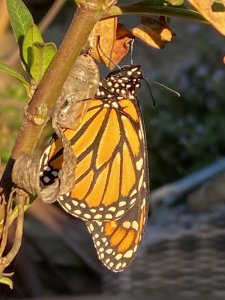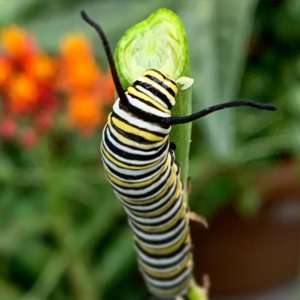Friends of China Camp – Spring 2021
MONARCHS ON THE BRINK
Help keep our native butterflies from disappearing forever
by Harriot Manley


For many of us, when we hear the word “butterfly,” an orange-and-black monarch comes to mind. Sadly, if current population trends continue, our minds may be the only place where these eye-catching insects remain, at least here along the California coast, as Western monarch populations flutter on the edge of extinction.
According to a recent report in the Marin Independent Journal, populations of western monarchs are “hanging by a thread,” says Janet Klein, Conservation and Community Science Director at Golden Gate National Parks Conservancy (GGNPC). The conservancy is part of a multi-agency effort to help save monarchs.
And it’s almost too late. Though Western monarch populations were estimated at 4.5 million in the 1980s, only 2,000 monarchs were spotted in California’s just-released Western Monarch Count for Winter 2020/21. Marin’s numbers are even grimmer. A paltry 200 monarchs were observed in the county this past winter, down from 38,700 of the butterflies counted in 2015.
Why the plummeting numbers? Experts note that likely culprits are pesticide use, climate change, and loss of trees and plants for overwintering, nectar, and breeding. An especially critical plant is native milkweed, where adults sip nectar and lay eggs, and the sole food source for monarch caterpillars.

While monarchs are found all over the world, and many migrate to central Mexico, the ones here have unique migration patterns. According to the California Department of Fish and Wildlife, Western monarchs cluster in specific trees and groves along the California coast, where they find moderated temperatures and protection from winter storms. Numerous sites have been identified in Marin, including Bolinas, Muir Beach, and Point Reyes. (Click on this map for specific locations.)
Public agencies as well as local groups including GGNPC and One Tam are now working to identify and improve overwintering habitat as well as protecting and expanding native milkweed populations. Though recent conservation efforts failed to get monarchs protection under the federal Endangered Species Act, projects like the one here in Marin County hope to make a difference. All of us can help, too.
4 ways to help Western monarchs
- Report when and where you see monarchs. If you see a monarch outside of overwintering groves, take a picture! (Don’t worry, it can be far away and blurry.) Share details using the iNaturalist app. Through April 22 (Earth Day), you can also submit images through the Western Monarch Mystery Challenge, or email them to monarchmystery@wsu.edu.
- Raise awareness. Share what you find on Facebook, Instagram, and Twitter. Tag posts with #SaveWesternMonarchs.
- Plant milkweed. Even a pot of native (not tropical) milkweed (Asclepias californica) can make a difference. California Dept. of Fish and Game has a helpful guide on how to plant it in your garden. Look for local sources with this Xerces Society milkweed link.
- Avoid pesticides. Some types, notably neonicotinoids, are particularly harmful to monarchs (and honeybees!).
For more ways to help protect our monarchs, download this detailed guide from the Xerces Society.

